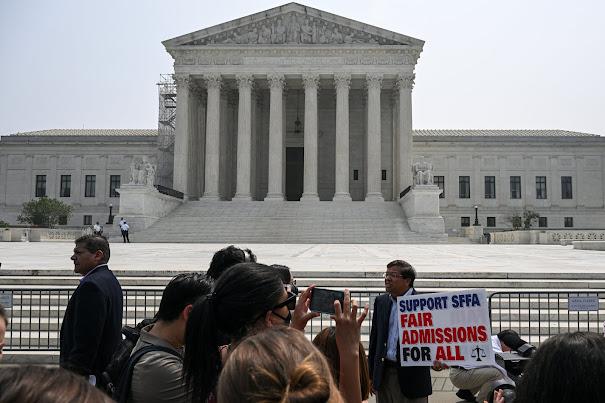The Supreme Court's landmark affirmative action decision on Thursday makes it illegal for colleges to take race into account as a distinguishing factor in admissions.
The decision means that entrance programs such as those at the two universities at the center of the case, Harvard University and the University of North Carolina, are no longer allowed.
Here are some other key implications of the decision.
Majority says race can still be part of admissions applications, minority disagrees
Although the decision will affect admissions policies that have historically benefited black and Latino students, the ruling still allows colleges and universities to consider an applicant's discussion of how race has affected their lives when until it is "tied up entirely" with "quality of character". or unique ability" that the applicant can bring to the school.
Chief Justice John Roberts said in the majority opinion that applicants can also share in the essay how their heritage or culture inspired them to pursue leadership roles.
The opinion states, "In other words, the student should be treated as an individual on the basis of his or her experiences—not on the basis of race."
Chief Justice John Roberts said in the majority opinion that applicants can also share in the essay how their heritage or culture inspired them to pursue leadership roles.
The opinion states, "In other words, the student should be treated as an individual on the basis of his or her experiences—not on the basis of race."
The dissenting Democratic-appointed justices objected and insisted that the ruling would make it practically impossible for colleges and universities to take race into account in admissions.
Justice Sonia Sotomayor wrote that the court was "merely" imposing its "preferred college application format" on the country, "taking over the role of college administrators to decide what is best for society."
He wrote, "Since the Court cannot escape from the inescapable truth that caste matters in the lives of students, it declares a false promise to save face and face reality." "No one's a fool."
Justice Sonia Sotomayor wrote that the court was "merely" imposing its "preferred college application format" on the country, "taking over the role of college administrators to decide what is best for society."
He wrote, "Since the Court cannot escape from the inescapable truth that caste matters in the lives of students, it declares a false promise to save face and face reality." "No one's a fool."
what hasn't changed
While colleges and universities will no longer be able to consider race as the sole factor, Sotomayor said in his dissent that the ruling still allows colleges and universities to consider other factors to increase diversity on campus.
Colleges may consider students who speak multiple languages or may be the first in their families to attend college, Sotomayor wrote.
Colleges may consider students who speak multiple languages or may be the first in their families to attend college, Sotomayor wrote.
"Those factors are not 'interchangeable' with race," he wrote.
The Biden administration also announced several plans Thursday to help colleges continue their efforts to recruit diverse student bodies in light of the decision. Those steps include issuing a report on strategies to increase diversity and educational opportunity and providing guidance on what schools are and are not allowed to do, among other things.
The Biden administration also announced several plans Thursday to help colleges continue their efforts to recruit diverse student bodies in light of the decision. Those steps include issuing a report on strategies to increase diversity and educational opportunity and providing guidance on what schools are and are not allowed to do, among other things.
Impact will vary state-by-state, school-by-school
Not all higher education institutions will be affected by this decision. The ruling allows US military service academies to continue to take race into account as a factor in admissions.
Steve Vladek, CNN Supreme Court analyst and University of Texas School of Law professor, said the impact could also vary depending on where schools are located.
In states that continue to allow colleges and universities to take race into account, "we will certainly see efforts to encourage the kinds of uses that the majority does not explicitly disapprove of—whether in diversity statements." Or anywhere else," he said.
Steve Vladek, CNN Supreme Court analyst and University of Texas School of Law professor, said the impact could also vary depending on where schools are located.
In states that continue to allow colleges and universities to take race into account, "we will certainly see efforts to encourage the kinds of uses that the majority does not explicitly disapprove of—whether in diversity statements." Or anywhere else," he said.


Post a Comment